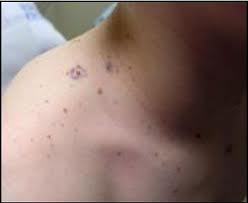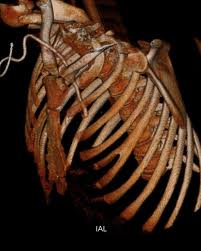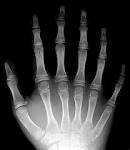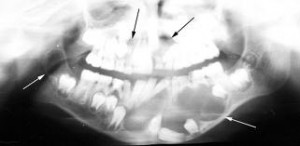What is Gorlin-Goltz syndrome?
It is a multisystemic disease characterized by a predisposition to neoplasms and other developmental abnormalities as will be listed down later. It was 1st described by Robert James Gorlin and Robert William Goltz in 1960.
Other names:
– Gorlin Syndrome
-Naevoid basal cell carcinoma syndrome (NBCCS)
How is it acquired?
It is acquired through autosomal dominant inheritance, meaning that if you inherit one gene for this syndrome from any one parent, you’ll inherit this syndrome.
Epidemiology
No sex prevalence
1 per 60,000
Occurs at about 2-3rd decade of age
What are the Signs and symptoms?
1. SKIN:
i) multiple naevoid basal cell carcinoma
– occurs in about 90% of cases
– usually starts in adolescence
– can occur on the face, chest, back
– the number varies in different individuals
– lighter-skin people are more prone to basal cell carcinoma
ii) Palmar and plantar pits
These are basically punctiform depressions in the skin of palms and soles of feet. The presence of three or more palmar pits constitutes a major diagnostic criterion in Gorlin syndrome.
2. ORAL:
- keratocystic odontogenic tumors (KCOTs) in the jaws (previously named odontogenic keratocyst, or OKC, but was reclassified by WHO as it better reflects its neoplastic nature)
– Its presence is usually the 1st symptom of NBCC, also occurs in 90% of cases
– usually starts in adolescence, recur until about 30 of age
- high-arched palate and mild prognathism (protrusion of the lower jaw)
3. SKELETAL:
- spine and rib anomalies (bifid ribs)
- Cleft lip and palate
- Polydactyly (extra fingers or toes)
4. CNS:
- calcification of the falx cerebri
- Brain tumours (most commonly medulloblastomas, which often occurs in childhood)
5. EYES:
- congenital cataract, microphthalmia (small eyes), orbital cysts,
- coloboma of the iris (tumour of the iris), strabismus (cross-eyed) and nystagmus (NYSTAGMUSÂ is characterized by an involuntary movement of the eyes, which may reduce vision or be associated with other, more serious, conditions that limit vision)
- telecanthus (distance between the medial canthi of the eyes is increased while the interpupillary distance is preserved )
6. OTHERS:
- Frontal bossing (protruding forehead)
- Other tumours such as fibromas of the heart and ovaries
- relative macrocephaly,
- broad nasal root, tubular nose
What genes are related to Gorlin syndrome?
Mutations in the PTCH1 gene cause Gorlin syndrome.The PTCH1 gene is a tumor suppressor gene, which means it keeps cells from proliferating too rapidly or in an uncontrolled way. This gene provides instructions for making a protein called Patched-1. Patched-1 prevents cell growth and division (proliferation).
Mutations in this gene prevent the production of Patched-1 or lead to the production of an abnormal version of the receptor. An altered or missing Patched-1 receptor cannot effectively suppress cell growth and division. As a result, cells proliferate uncontrollably to form the tumors that are characteristic of Gorlin syndrome.
What is the treatment for Gorlin’s syndrome?
For keratocystic odontogenic tumour (KOTs)
- Â Conservative vs aggressive approach
Conservative approach:
i)Â Enucleation, with or without curettage
ii) Marsupialization
Advantage of conservative approach: preservation of anatomical structures (including teeth), hence is the treatment of choice in younger patients. However, it follows that the recurrence rate of KCOT with this treatment is higher than that of aggressive treatment.
Aggressive approach:
-Aggressive approach addresses the neoplastic nature of KCOTs, recommended for NBCCS cases, large KCOTs and recurrent lesions
i)Â Â Peripheral ostectomy
ii) Chemical curettage with fixative Carnoy’s solution
iii) En bloc resection
iv) Cryotherapy (freezing) with liquid nitrogen
–Cryotherapy and use of Carnoy’s solution both address residual tissue to prevent recurrence
-Advantage of aggressive approach: Lower recurrence rate
Factors to consider in choosing Treatment option:
- Â Lesion size
- Â Lesion extension
- Â Location
- Â Possible cortical and soft tissue damage
- Â Age
- Â Whether it is a primary or recurrent lesion
Multidisciplinary Approach:
1. Dental: Periodic clinical and radiological follow up (3-4 times a year) to check any early signs of recurrence
2. Dermato: All patients with Gorlin’s syndrome should see a dermatologist for regular skin examinations so that basal cell carcinomas can be treated when they are small. This may require surgery or one of the many other treatments available for these tumours including cryotherapy, photodynamic therapy, and flourouracil cream.They should not receive treatment with irradiation as this is liable to provoke the development of more tumours.
-Sun protection is vital to reduce the number of skin cancers developing but even complete protection will not prevent all basal cell carcinomas in patients with Gorlin’s syndrome.
3. Neuro
4. Ophthalmo
5. Cardio
The whole family should be examined and genetic counseling that considers the genetic risks is advisable for all patients with this syndrome, both familial and sporadic.



